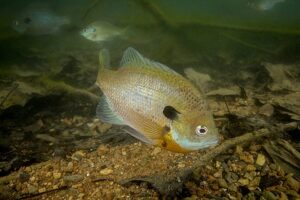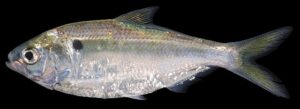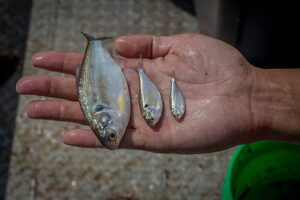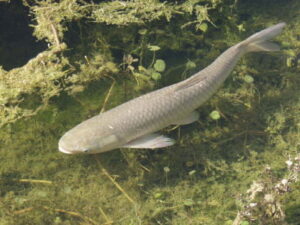Stix fishing Education
The Spawns
This month we are taking an in-depth dive into all things spawn. From the bass spawning at your favorite place to fish, to the spawns of the baitfish and bream that the bass will feed on. We got you covered with the following tips, techniques, and information to help you catch more and bigger bass during the spawns you face on the water!
For each type of spawn, we’ve paired six universal lures (STIX Picks) that are the best approach in our opinion for consistently catching big bass in each spawn related scenario. Simply click the tab to your left to skip to the type of spawn you’d like to learn more about or start below to read about each spawn. Check back soon, as we’ll be adding more suggestions, photos, baits, and videos as we continue to dissect the spring spawns this month!
Bass Spawn Overview:
Here are general rule-of-thumb water temperature considerations for the bass spawns:
-55-60 degrees: Many bass will be staging, and greater numbers will be moving in to spawn
-60-70 degrees: Bass will be either moving in to spawn, spawning, or leaving the nest. This is a dynamic phase of the bass spawn, as anglers may often find all three stages of prespawn, spawn, and postspawn activity from the bass. Target prespawners on migration routes and drops close to bedding areas.
-70-80 degrees: A few bass will still be spawning, but many have left the nest and are on migration routes to deeper water. Deeper, thicker, and current are three key words to remember during this phase, as bass tend to seek deeper water, thicker cover such as matted vegetation, or current on the main river channel. These are great places for the bass to recover from the spawn and feed.
Largemouth Bass Spawn:
 Largemouth bass spawning usually occurs when water temperatures range between 65 – 75°F. The largest waves of spawning bass activity generally occur within three days of each full moon or new moon lunar cycle. The male bass builds a circular-shaped bed in shallow water areas. One or more female bass will arrive to deposit eggs in the bed while the male fertilizes them. Generally, the male stays to guard the eggs until they hatch within the next couple days. The male often stays around to guard the hatchlings, called the fry, for a few more weeks.
Largemouth bass spawning usually occurs when water temperatures range between 65 – 75°F. The largest waves of spawning bass activity generally occur within three days of each full moon or new moon lunar cycle. The male bass builds a circular-shaped bed in shallow water areas. One or more female bass will arrive to deposit eggs in the bed while the male fertilizes them. Generally, the male stays to guard the eggs until they hatch within the next couple days. The male often stays around to guard the hatchlings, called the fry, for a few more weeks.
-Quick Tip: Try catching the male first. Sometimes this angers the female and gets her to lock on to the bed to defend it. Another key consideration is to be quiet and distant when approaching the bed to not spook the fish. Observing tail movement and the bass’ attention (or lack of attention) to your bait is important to deciding if its worth staying a while and fishing for, or moving on to look for another bed!
-STIX Picks:
#1 Finesse Spin STIK: Shaky head with soft stick bait
#2 Hybrid Spin STIK: Wacky rigged worm
#3 Hybrid STIK: Buzzbait
#4 Reaction STIK: Bladed Jig
#5 Surface STIK: Texas Rigged Soft Plastics
#6 Power STIK: Frog
Smallmouth Bass Spawn:

A male smallmouth bass will begin to build a bed in clean substrate, hard bottom areas such as pea gravel and pebble bottoms when water temperatures climb into the upper 50s and 60s. Smallmouths will look for slack-water areas directly out of the current, or seek out an eddy in shallow water behind boulders, laydown trees, or other obstructions that block the current for the ideal area to build and protect the nest from fast moving water. Smallmouth bass are known for defending a wider radius distance perimeter from their beds compared to largemouth.
-STIX Picks:
#1 Finesse Spin STIK: Ned rig
#2 Hybrid Spin STIK: Dropshot
#3 Hybrid STIK: Ball head jighead with soft swimbait
#4 Reaction STIK: Deep diving jerkbait
#5 Surface STIK: Jighead with soft plastic tube
#6 Power STIK: Umbrella rig with soft swimbaits
Spotted Bass Spawn:
Spotted bass prefer to spawn around mixed rock, gravel, and lightly sandy hard bottom areas as water temperatures climb into the upper 50’s through mid 70’s. Nest depths may vary widely depending on the contours and water clarity of the area.
-STIX Picks:
#1 Finesse Spin STIK: Shaky head jighead with finesse straight tail worm
#2 Hybrid Spin STIK: Dropshot with finesse straight tail worm
#3 Hybrid STIK: Walking topwater bait
#4 Reaction STIK: Lipless crankbait
#5 Surface STIK: Carolina Rig
#6 Power STIK: Glide bait
Bream Spawn:
 Bream (Sunfish/ Panfish) spawn as the water temperature warms into the upper 70’s and into the 80’s. Larger waves of spawning bream occur around the full and new moon cycles. Bream beds often look like a honeycomb pattern, with clusters of small beds grouped together in sandy, leafy mixed bottom areas. Check coves and pockets for wolfpacks of bass to be feeding in these areas at sunrise and patrolling the areas throughout the day. Shady tree overhangs, docks, and the very back of the coves are common areas to find bream beds.
Bream (Sunfish/ Panfish) spawn as the water temperature warms into the upper 70’s and into the 80’s. Larger waves of spawning bream occur around the full and new moon cycles. Bream beds often look like a honeycomb pattern, with clusters of small beds grouped together in sandy, leafy mixed bottom areas. Check coves and pockets for wolfpacks of bass to be feeding in these areas at sunrise and patrolling the areas throughout the day. Shady tree overhangs, docks, and the very back of the coves are common areas to find bream beds.
-STIX Picks:
#1 Finesse Spin STIK: Soft plastic jerkbait
#2 Hybrid Spin STIK: Wacky rigged soft plastic stick bait
#3 Hybrid STIK: Topwater popper
#4 Reaction STIK: Bladed Jig
#5 Surface STIK: Casting swim jig
#6 Power STIK: Popping frog
Threadfin Shad Spawn:
 Threadfin shad are a very common baitfish found in many lakes and rivers. Adult threadfin shad rarely exceed 6 inches in length. Threadfin shad spawning begins in the spring when water temperatures reach approximately 70°F, and may continue into the early summer. During spawning, one or more females are accompanied by several males. Spawning occurs generally in the upper five feet of water around rock, seawalls, and grass beds. Bridges are very common places to find threadfin spawning in the first few morning hours and are a great place to start looking for shad spawn activity at first daylight.
Threadfin shad are a very common baitfish found in many lakes and rivers. Adult threadfin shad rarely exceed 6 inches in length. Threadfin shad spawning begins in the spring when water temperatures reach approximately 70°F, and may continue into the early summer. During spawning, one or more females are accompanied by several males. Spawning occurs generally in the upper five feet of water around rock, seawalls, and grass beds. Bridges are very common places to find threadfin spawning in the first few morning hours and are a great place to start looking for shad spawn activity at first daylight.
-Quick Tip: Throw a spinnerbait around shallow rocky banks and underwater grassbeds at first daylight. If threadfin shad are spawning in the area, you will see them follow the spinnerbait in, as they are attracted by the vibrations of the blades.
-STIX Picks:
#1 Finesse Spin STIK: Soft plastic jerkbait
#2 Hybrid Spin STIK: Wacky rig soft plastic stick bait
#3 Hybrid STIK: Spinnerbait
#4 Reaction STIK: Bladed Jig
#5 Surface STIK: Swim Jig
#6 Power STIK: Popping frog
Gizzard Shad Spawn:
 Gizzard shad spawning activity takes place in mid to late spring, usually in shallow protected water. Schools of gizzard shad swarm shallow banks releasing eggs and milt. The eggs are very adhesive and attach to submerged objects such as vegetation.
Gizzard shad spawning activity takes place in mid to late spring, usually in shallow protected water. Schools of gizzard shad swarm shallow banks releasing eggs and milt. The eggs are very adhesive and attach to submerged objects such as vegetation.
-Quick Tip: Throw a spinnerbait around shallow rocky banks and underwater grassbeds. If gizzard shad are spawning in the area, you will see them follow the spinnerbait in, as they are attracted by the vibrations of the blades.
-STIX Picks:
#1 Finesse Spin STIK: Weightless soft plastic jerkbait
#2 Hybrid Spin STIK: Soft plastic hollow body swimbait on jighead
#3 Hybrid STIK: Spinnerbait
#4 Reaction STIK: Bladed Jig
#5 Surface STIK: Glide Bait
#6 Power STIK: Umbrella Rig with blades, soft plastic hollow body swimbaits on jigheads
Blueback Herring Spawn:

Blueback herring spawn in mid to late spring as water temperatures climb into the upper 60’s and 70’s. Look for the best herring spawn spots to not be far from main lake and creek channel rocky banks, rip rap, bridge pilings, points, islands, and submerged humps. Blueback herring may spawn throughout the day, so keep your eyes on the lookout for activity.
-Quick Tip: Throw a spinnerbait resembling a herring around rocky and other hard structure. If blueback herring are spawning in the area, you will see either see them pulsing on the surface or following the spinnerbait in, as they are attracted by the vibrations of the blades.
-STIX Picks:
#1 Finesse Spin STIK: Soft plastic swimbait on jighead
#2 Hybrid Spin STIK: Dropshot
#3 Hybrid STIK: Spinnerbait
#4 Reaction STIK: Jerkbait
#5 Surface STIK: Topwater walking bait
#6 Power STIK: Big hard jointed swimbait/ glidebait
Carp Spawn:
 Large numbers of carp spawning in an area is a scenario notorious for disrupting the bass spawn or just simply driving the bass out of the area with all the commotion and muddy water. If you feel that the area or grassbed you are fishing has been overrun, it may be a good idea to go somewhere else that the carp haven’t taken over yet!
Large numbers of carp spawning in an area is a scenario notorious for disrupting the bass spawn or just simply driving the bass out of the area with all the commotion and muddy water. If you feel that the area or grassbed you are fishing has been overrun, it may be a good idea to go somewhere else that the carp haven’t taken over yet!
